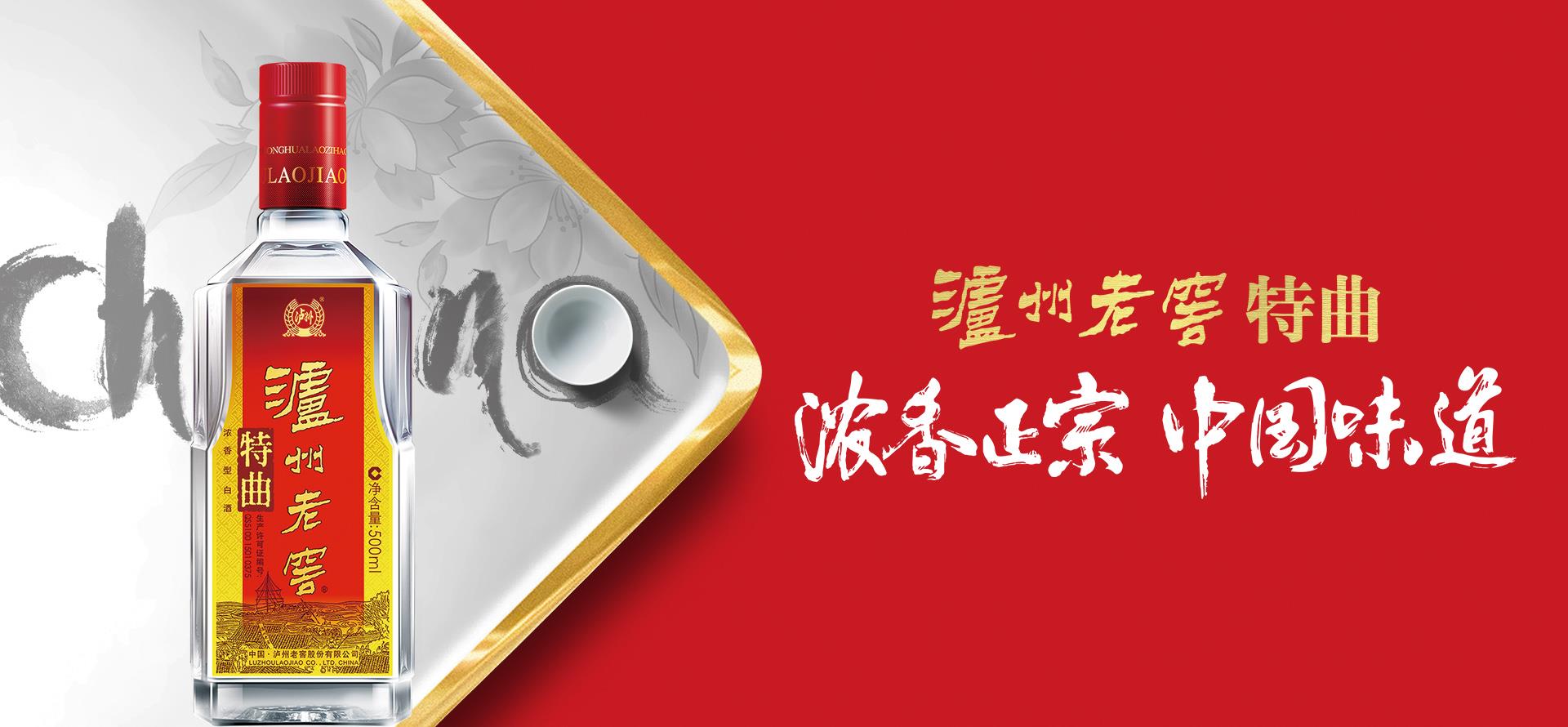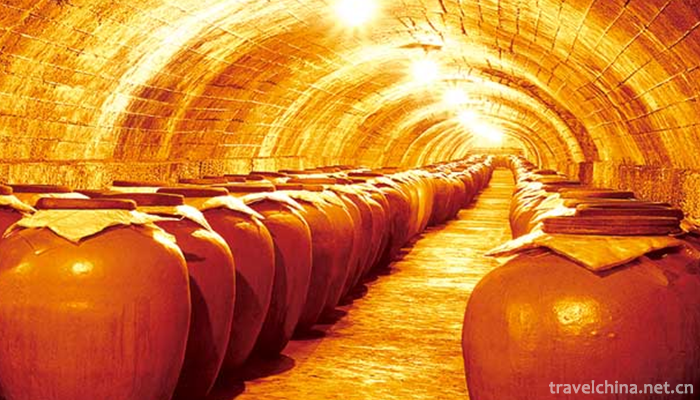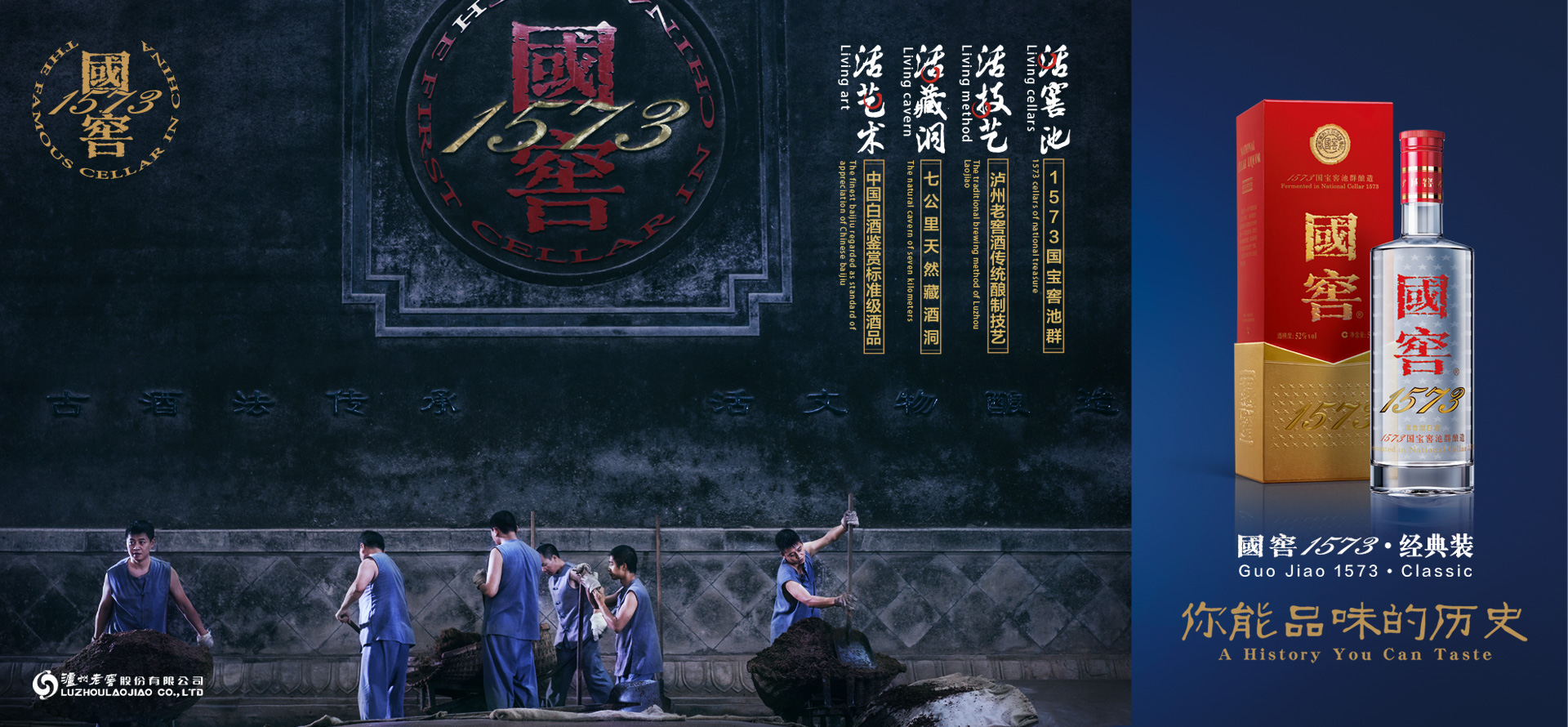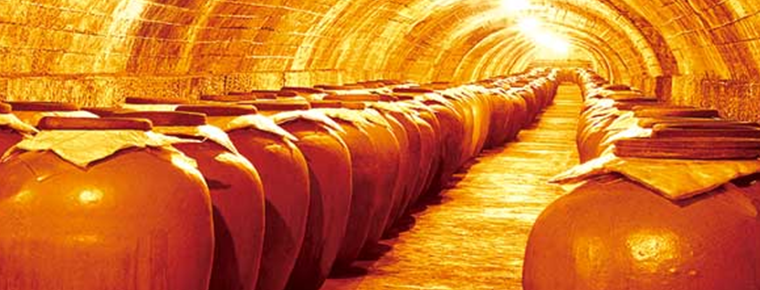Brewing Techniques of Luzhou Laojiao Liquor
Brewing Techniques of Luzhou Laojiao Liquor
Luzhou Laojiao Liquor Brewing Technology, Luzhou City, Sichuan Province, the local traditional handicraft, one of the national intangible cultural heritage.
The brewing process of Luzhou Laojiao Liquor is complicated. Luzhou Laojiao Liquor is finally brewed through 12 processes, such as selecting raw materials, crushing, mixing grain and moistening grain, mixing bran, steaming grain in steamer, picking wine, steaming and drying in steamer, mixing starter, entering cellar, sealing cellar fermentation, dripping yellow water in cellar, starting and transporting mother's grains and stacking mother's grains.
On May 20, 2006, the brewing technology of Luzhou Laojiao Liquor was approved by the State Council of the People's Republic of China and listed in the first batch of national intangible cultural heritage list, item number_-58.
historical origin
The brewing techniques of Luzhou Laojiao Liquor originated from Gujiangyang. It was gradually bred and flourished in Tang and Song Dynasties under the special historical and spatial atmosphere of the development of liquor industry in southern Sichuan since Qin and Han Dynasties. It was created, embryonic, stereotyped and mature in Yuan, Ming and Qing Dynasties. It was handed down from generation to generation and formed a unique and world-class liquor culture.
Song Dynasty is a very important period. At that time, Luzhou people had mastered the method of making wine. The liquor of that time was similar to Luzhou people's Luzhou-flavor liquor in terms of raw material selection, process operation, fermentation method and liquor taste quality. It can be said that is the root of Luzhou Laojiao. The history of Luzhou Laojiao began at that time.
The emergence of liquor in Song Dynasty opened a new chapter for the development of Luzhou liquor industry. Unfortunately, the remains of Luzhou liquor culture in Song Dynasty were destroyed in the long war. It was not until the Ming Dynasty that Luzhou, a wine city, regained its former prosperity.
In the thirteenth year of Wanli in Ming Dynasty (1586), the technology of Luzhou Daqu liquor was preliminarily formed.
Around the 14th year of Shunzhi in Qing Dynasty (1657), Shujuyuan Waste Square opened.
In Qianlong's 22nd year (1757), four more wine cellars were built, and Daqu liquor was well known. At the end of the Qing Dynasty, there were more than 600 households of white distillers'grains, and since the Republic of China, there have been more than 300 households of white distillers' grains. There are more than ten households in Daqu, aged cellars, especially Qingquan. They are famous for Wen Yongsheng and Tiancheng.
In 1949, there were 36 wineries in Luzhou. From 1951 to 1952, four joint-venture wineries, Chunhe Rong, Wen Yongsheng, Dingji and Qulian, were formed.
In 1955, four joint-venture wineries were merged to form a public-private joint-venture winery, and its first liquor factory was transformed into a local state-owned winery.
In 1960, the two factories were merged into Luzhou Qujiu Winery.
In 1990, with the approval of the Luzhou Municipal People's Government, it was changed to the present factory name, Luzhou Laojiao Winery.
Process characteristics
The traditional brewing techniques of Luzhou Laojiao Liquor include mud pit production and maintenance, Daqu medicine production and evaluation, wine picking, wine aging, blending and tasting, etc.
Luzhou Laojiao Liquor is brewed with glutinous sorghum as raw material and soft wheat as starter-making raw material. Its brewing techniques include mud cellar production and maintenance, Daqu medicine production and evaluation, original wine brewing, digging trough, flower picking, steamer steaming, stall drying, wine-telling, cave storage, blending and tasting. The fermentation period of Luzhou Laojiao Liquor is sixty days. The fermentation technology includes mixing distiller's grains and continuous residue ingredients. In addition, the strong aroma of the finished wine can be improved by using the fermentation technology of "stratified wine return" and "double bottom".
Luzhou Laojiao Liquor, named for its long-term fermentation, is the representative of Luzhou-flavor liquor in China. According to its quality, Luzhou Laojiao Daqu liquor can be divided into special, first, second and third. Luzhou Tequ liquor is the best liquor with strong aroma, mellow, sweet taste and long aftertaste.
Technological process
The technological process of the original liquor brewing in Luzhou Laojiao is mainly divided into sorghum sorghum crushing (4-6 petals of broken grain, deep digging and low releasing of mixing materials) digging grains distilling grains mixing bran steaming grains steaming wine steaming grains steaming grains steaming wine picking wine distilling wine in the distillation process. Because of the different surface tension between alcohol and water, different alcoholic degrees (alcoholic concentration) show different sizes of droplets (commonly known as hops), and the length of stay is different, so we can judge the alcoholic degrees to grasp the time of wine extraction; pinch the head and cut off the tail: in the distillation process, the first part of wine is called hop head, when the hop changes from big flower to fine flower. When flowering, pick the lower part of the remaining alcoholic liquor separately, until the outflow does not contain alcoholic liquor, pick the part called the tail.
Steam distillation from fermented grains distilled grains to be cooled ("beating stalks" to be cooled) distilled grains to mix koji medicine (drug mixing "kick hands hands") distilled grains to be fermented in cellar sealed cellar fermentation (fermented into cellar fermentation "slow, moderate, slow down down down down down down down down down") open cellar identification (open cellar identification "one look, two smell, three tastes") distilled grains to yellow water (yellow water trickling yellow water (yellow water dilution dilution cellar), stratified cellar dripping yellow water, stratified cellar, stacking cellar, stratified cellar, stacking and stacking and Bad) Shipping mother's waste Piling mother's waste Digging waste( Brewing techniques of raw wine such as batching of renewed grains, recycling of cellar, etc.
Inheritance and protection
Inheritance value
Luzhou Laojiao Liquor is the representative of Luzhou-flavor liquor in China. The production, inheritance and development of related brewing techniques are all in Luzhou City, southern Sichuan Province.
The traditional brewing techniques of Luzhou Laojiao Liquor enjoy the reputation of "living cultural relics" in the Chinese liquor industry. It is a typical example of Chinese liquor-making technology and liquor culture. Even today, it is difficult to replace them with modern technology. As a precious intangible cultural heritage of the world wine industry, this traditional skill needs to be protected and developed urgently.
Inheriting characters
Shen Caihong, male, was born in March 1966. In June 2007, Shen Caihong was selected as the representative successor of the first batch of national intangible cultural heritage projects, which was declared by Luzhou City, Sichuan Province. Project Name: Brewing Techniques of Luzhou Laojiao Liquor.
Lai Gaohuai, male, was born in February 1934. In June 2007, Lai Gaohuai was selected as the representative successor of the first batch of national intangible cultural heritage projects, which was declared by Luzhou City, Sichuan Province. Project Name: Brewing Techniques of Luzhou Laojiao Liquor.
Zhang Liang, male, was born in November 1965. In December 2012, Zhang Liang was selected as the representative successor of the fourth batch of national intangible cultural heritage projects, which was declared by Luzhou City, Sichuan Province. Project Name: Brewing Techniques of Luzhou Laojiao Liquor.
protective measures
In 1996, Luzhou Laojiao Ming Dynasty cellar group was selected as the fourth batch of national key cultural relics protection units.
In 2006, "Luzhou Laojiao Liquor Traditional Brewing Techniques" was listed as "the first batch of national intangible cultural heritage masterpieces" by the State Council.
In 2011, the Luzhou Municipal People's Government initiated the establishment of the Professional Committee for the Protection of Ancient Chinese Wine Sites of the Luzhou Laojiao Society of Chinese Cultural Heritage to strengthen the protection and research of wine cultural heritage and promote the scientific development of the protection of Chinese wine cultural heritage.
In 2013, "1573 old cellars and 16 Ming and Qing workshops, 1615 cellars and 3 major wine storage caves" in Luzhou Laojiao were listed in the seventh batch of state key cultural relics protection units and in the "Preparatory List of China's World Cultural Heritage".
In 2018, the Luzhou Municipal People's Government promulgated the Regulations on the Protection and Development of the Historical and Cultural Heritage of Luzhou Liquor to protect the old cellars, old workshops, wine storage spaces and technical representatives of traditional brewing techniques.
The Luzhou Laojiao Museum, founded in 1991, was a Provincial Museum in 2008. In October 2018, it held a cultural co-construction signing ceremony with Jilin Provincial Liquor Culture Museum, aiming at spreading the liquor culture of Luzhou Laojiao and inheriting the brewing techniques of Luzhou Laojiao Liquor.
social influence
Important exhibition
In 1915, Luzhou Laojiao Liquor selected typical wines to participate in the International Exposition held in Panama Wan, and won the Gold Prize. Since then, it has gained international fame.
In 1990, a special song of Luzhou Laojiao was exhibited at the International Food Exposition in Paris, participated in the evaluation of many famous wines, and won the gold medal in the last move.
Honorary commendation
In 1915, Luzhou Laojiao Wine won the Panamanian Gold Medal at Panama World Expo.
In 1990, Luzhou Tequ of Luzhou Laojiao Liquor Series won the Gold Prize at the International Food Exposition in Paris.
In August 1992, Luzhou Tequ won the gold medal at the Russian Food Exposition.
In 1992, Luzhou Laojiao Wine won the gold medal at the Pacific Expo in Los Angeles, USA.
In 1992, Luzhou Laojiao Wine won a special gold medal in Budapest, Hungary.
In 1994, Luzhou Laojiao Wine won a special gold medal at Panama World Wine Exposition.





-
2.Online Shopping
Online shopping is to retrieve commodity information through the Internet, and send out shopping requests through electronic order forms, then fill in the number
Time 2018-11-13 -
3.Kedao
Kedao, the local traditional folk literature of Shibing County, Guizhou Province, is one of the national intangible cultural heritage.
Time 2018-12-15 -
4.Nansha Garden Hotel Guangzhou
Nansha Garden Hotel, a brand-new landmark building in Dawan District and New Nansha, was commissioned on June 20, 2018. The brand of Garden Hotel added a unique creative design hotel.
Time 2018-12-16 -
5.Qingming Bridge Ancient Canal Scenic Area
Qingming Bridge Ancient Canal Scenic Area is located at the southern end of Wuxi city center, covering about 44 hectares of scenic area. The scenic spot is composed
Time 2019-02-07 -
6.Six Arts City of Confucius in Qufu
Confucius Liuyi City is located at No. 15 Chunqiu Road, Nanxin District, Qufu City, Jining City, Shandong Province. It is constructed by means of modern high-tech technology
Time 2019-02-07 -
7.South China Sea Channel
South China Sea Channel is a traditional folk culture in Wenchang City, Hainan Province. Local fishermen have compiled their own "secret book" for navigation since ancient times. It is a han
Time 2019-06-07 -
8.Mantis Boxing
Mantis boxing is one of the famous Chinese traditional Wushu schools, and it is a kind of hieroglyphic boxing. It is one of the four famous boxing in Shandong Province and one of the first nine school
Time 2019-06-18 -
9.Uygur moulding earthenware firing
Uygur moulding pottery has a history of more than two thousand years. After the middle of the ninth century, Uygur ancestors moved westward to the vicinity of the Tarim Basin, inherited the pottery ma
Time 2019-06-26 -
10.Du Mu
Du Mu (803 years - 852 years), Zi Mu Zhi, Fan Chuan Chuan, Han, Jing Zhao Wan (now Shaanxi Xi'an). Du Mu is Tang dynasty Outstanding poets, An essayist The prime minister. Du you Sun, Du from Yu Son.
Time 2019-09-07 -
11.Luocheng ancient town
Luocheng ancient town, known as "China's Noah Ark", is located in the northeast of Qianwei County, 60 kilometers away from Leshan City and 25 kilometers away from Qianwei county. There are seven ethnic groups, Han, Hui, Yi, man, Tibetan, Li and Miao.
Time 2020-10-15 -
12.Neijiang economy
In 2019, the GDP of Neijiang City will reach 143.33 billion yuan, an increase of 7.8% over the previous year in terms of comparable prices. Among them, the added value of the primary industry was 24.050 billion yuan, an increase of 2.9%; the added value
Time 2020-12-16